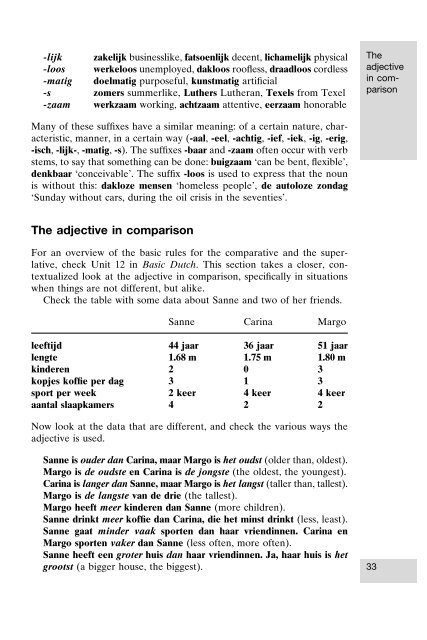er - Home
er - Home
er - Home
Create successful ePaper yourself
Turn your PDF publications into a flip-book with our unique Google optimized e-Paper software.
-lijk zakelijk businesslike, fatsoenlijk decent, lichamelijk physical<br />
-loos w<strong>er</strong>keloos unemployed, dakloos roofless, draadloos cordless<br />
-matig doelmatig purposeful, kunstmatig artificial<br />
-s zom<strong>er</strong>s summ<strong>er</strong>like, Luth<strong>er</strong>s Luth<strong>er</strong>an, Texels from Texel<br />
-zaam w<strong>er</strong>kzaam working, achtzaam attentive, e<strong>er</strong>zaam honorable<br />
Many of these suffixes have a similar meaning: of a c<strong>er</strong>tain nature, charact<strong>er</strong>istic,<br />
mann<strong>er</strong>, in a c<strong>er</strong>tain way (-aal, -eel, -achtig, -ief, -iek, -ig, -<strong>er</strong>ig,<br />
-isch, -lijk-, -matig, -s). The suffixes -baar and -zaam often occur with v<strong>er</strong>b<br />
stems, to say that something can be done: buigzaam ‘can be bent, flexible’,<br />
denkbaar ‘conceivable’. The suffix -loos is used to express that the noun<br />
is without this: dakloze mensen ‘homeless people’, de autoloze zondag<br />
‘Sunday without cars, during the oil crisis in the seventies’.<br />
The adjective in comparison<br />
For an ov<strong>er</strong>view of the basic rules for the comparative and the sup<strong>er</strong>lative,<br />
check Unit 12 in Basic Dutch. This section takes a clos<strong>er</strong>, contextualized<br />
look at the adjective in comparison, specifically in situations<br />
when things are not diff<strong>er</strong>ent, but alike.<br />
Check the table with some data about Sanne and two of h<strong>er</strong> friends.<br />
Sanne Carina Margo<br />
leeftijd 44 jaar 36 jaar 51 jaar<br />
lengte 1.68 m 1.75 m 1.80 m<br />
kind<strong>er</strong>en 2 0 3<br />
kopjes koffie p<strong>er</strong> dag 3 1 3<br />
sport p<strong>er</strong> week 2 ke<strong>er</strong> 4 ke<strong>er</strong> 4 ke<strong>er</strong><br />
aantal slaapkam<strong>er</strong>s 4 2 2<br />
Now look at the data that are diff<strong>er</strong>ent, and check the various ways the<br />
adjective is used.<br />
Sanne is oud<strong>er</strong> dan Carina, maar Margo is het oudst (old<strong>er</strong> than, oldest).<br />
Margo is de oudste en Carina is de jongste (the oldest, the youngest).<br />
Carina is lang<strong>er</strong> dan Sanne, maar Margo is het langst (tall<strong>er</strong> than, tallest).<br />
Margo is de langste van de drie (the tallest).<br />
Margo heeft me<strong>er</strong> kind<strong>er</strong>en dan Sanne (more children).<br />
Sanne drinkt me<strong>er</strong> koffie dan Carina, die het minst drinkt (less, least).<br />
Sanne gaat mind<strong>er</strong> vaak sporten dan haar vriendinnen. Carina en<br />
Margo sporten vak<strong>er</strong> dan Sanne (less often, more often).<br />
Sanne heeft een grot<strong>er</strong> huis dan haar vriendinnen. Ja, haar huis is het<br />
grootst (a bigg<strong>er</strong> house, the biggest).<br />
The<br />
adjective<br />
in comparison<br />
33


